The Long-Term Positivity of Multi-Cultural Children’s Books

It is common knowledge that there is current rise of multi-cultural main characters in children’s literature. And for good reason, because every child deserves to be represented in the pages they read. Please be aware that children’s literature involves picture books, middle-grade books, and young adult novels. Middle-grade books usually run for ages 9-14 and young adult ranges between 14-29. But it is widely known that people older than 29 are still reading young adult novels because, well, they will always be relatable and relevant to society. It is safe to assume that many of us will always have our inner, teenage self. Twenty-to-thirty years ago, it was rare to see people of color as a book’s main character. Now, all children have a higher chance of coming across a book cover with a protagonist that looks and is like them.

Stef Soto, Taco Queen by Jennifer Torres is among the children’s books that have been recently published with a young Mexican-American protagonist. The story starts out with middle grader Stef Soto, explaining how she does not like that her father, Mr. Soto, picks her up in their family taco truck, named ‘Tía Perla”. As the reader moves along, she/he comes across Spanish vocabulary such as “Órale”, “Gracias”, “Vámonos”, and “¿Aprendiste algo?” For a young reader who grew up in a Spanish-speaking household, these little Spanish nuggets can bring tremendous joy! As stated in the 2012 New York Times article 1 “For Young Latino Readers, An Image is Missing”, kids have a different kind of connection to a fictional character when they see she/he looks like them. Furthermore, when the book’s themes relate to something they have experienced in their own lives, they may be willing to buy more books! It cannot be overstated how great it is that publishers are now expanding the diversity of their children’s books.
In this middle-grade novel, Stef struggles to be proud of her family culture because she is bullied, being called ‘taco queen’ by her classmates. While Stef loves her family food, she cannot tolerate seeming to smell like tacos and having to translate official documents for her parents. Translating important adult documents may be highly intimidating for a young child, as confirmed in “Kids Serve As Translators For Parents Who Speak Little English” 2, and it is something commonly not talked about among middle-graders. However, as one continues to read Stef’s story, the reader sees that Stef learns to accept the important role she plays in her parents’ lives.
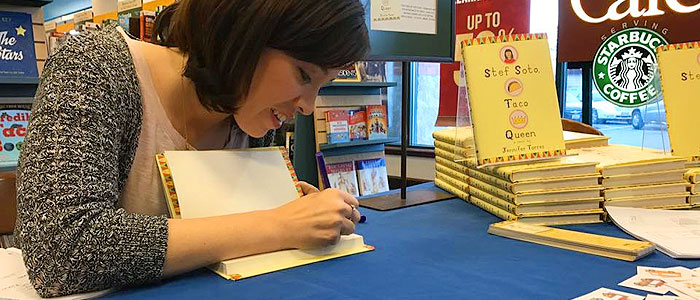
Audiences then read how Stef’s dad is in danger of losing “Tía Perla” when government officials decide to pass new laws on how food vendors will be allowed to continue their food truck businesses. ‘Tía Perla” was initially Stef’s greatest shame because of the bullying she received from peers. But when Stef realizes the importance the family food truck plays in helping her parents buy everyday necessities, she has a change of heart. Reading this can also help a young multi-cultural reader gain the courage to take on the world with pride. As Bernice Cullinan explains in “Reading with Your Child” 3 children can think about the stories they have read, because words have meaning and they can learn about life and its many cultures.
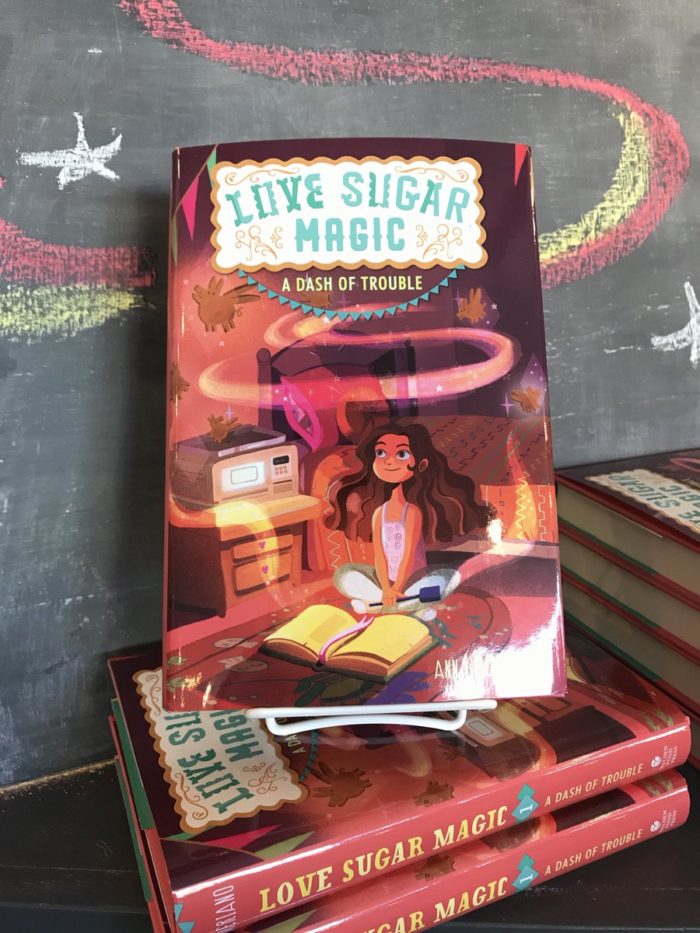
In Anna Meriano’s Love, Sugar, Magic: A Dash of Trouble, we are introduced to eleven-year old Leonora Logroño’s family traditions – celebrating Halloween and Día de los Muertos (The Day of the Dead). The setting takes place in Rose Hill, Texas, with Leo’s family owning the Amor y Azúcar Panadería (Love and Sugar Bakery). The reader is immediately immersed in the mouth-watering foods mentioned throughout the story. As the reader delves further into the story, she/he reads about popular Latinx foods such as “quesadillas” and delectable “conchas” (sweet Mexican bread in the shape of a conch shell). The role food plays in the story’s plot is crucial because young Leo dreams to be allowed to help with their family festivities, especially cooking. But due to her young age, her parents do not allow her in on the family secret – her family has a special power, the power of magic sweetness from love and sugar! They are able to add a magical element to the foods baked! But boy, does Leo sure want to prove herself.
The mentioning of Latinx (in this case Mexican) foods can not only make a multi-cultural reader feel welcomed, it can also introduce new foods to readers not familiar with them (i.e., non-Latinx readers or Latinx readers who haven’t tried Mexican foods yet). In addition, the Spanish language inserted can motivate young readers to want to learn the language more. As mentioned in Interlinear Books Blog 5, reading is a great way to learn new words through the context of the story. Furthermore, readers who know about the culture central to the plot have the honor of feeling proud and empowered to see themselves reflected in the characters they read about.

Adding on to the joy of seeing themselves culturally reflected in literature, young readers can relate to Leo’s mission to prove that, as the youngest one of the family, they can be the biggest help of all.
A Field Guide To Ruffling Diverse Feathers

Young readers are introduced to not one, but four very unique and diverse protagonists – Ofelia Castillo, Lane DiSanti, Aster Douglas, and Cat Garcia – in the middle-grade novel Strange Birds: A Field Guide To Ruffling Feathers by Celia C. Pérez. It is widely known that middle school years (6th-8th grade) are one of the hardest stages for young people due to the emotional and physical changes they are going through. Told from the alternating perspectives of our four young heroines, readers from all backgrounds (Latinx/Latino/Latina, Asian, African, Caucasian, etc.) will be able to emotionally connect with them.
The story’s plot focuses on Cat’s longing to put an end to the use of a famous feathered hat used by the Floras troop (i.e., club or girls scout). However, she is pressured by her mother, Mrs. Garcia, to remain in the club because “her mom credited her own successes in life in part to her involvement with the Floras. [Cat being a part of the Floras] was a big deal to her” (Pérez, 51). There is no doubt that reading Cat’s perspective will resonate with many readers (both young and older) who have been pressured at some point in their lives by their parents/guardians, to be someone they do not want to be. As stated in the Diversity Best Practices 7 online article, “in response to external stimuli, [Latinos] can accept and internalize their cultural surroundings, deny them, or change them.” Cat refuses to continue with the Floras troop because she is a bird-watcher and activist, and their feathered-hat tradition disrespects her beliefs, to the point that their leader, Mrs. McAllister, insisted Cat’s beliefs shouldn’t be acknowledged. Talk about middle-grade drama!
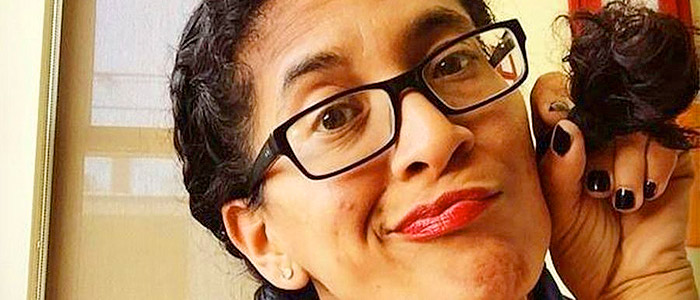
Cat might not know it at first, but she is not alone. Her three allies: Ofelia, the storyteller; Lane, the artist; and Aster, the chef, will have to find a way with her to dismiss their differences and take down the popular Floras troop. Lane and Aster are the dynamic duo whose family history ties them together, while emphasizing the socio-economic barriers that they must stand against. Their interaction and powerful language will make young readers from both high and low-income backgrounds feel seen and heard. Take this strong, riveting paragraph that Celia C. Pérez crafted;
“You live on the west side of the Wall,” Aster rolled her eyes [at Lane]. “What wall?” Lane asked. [Aster responds,] “It’s not a real wall. East side is poor, mostly Black, west side is…different.” “Different how?” Lane asked, raising an eyebrow. “Look around, Lane. Different mostly white, different mostly not poor.” “Just because I’m not poor or because I’m white doesn’t mean I don’t have problems too.” Lane said defensively.
From Celia C. Pérez’s Strange Birds
There aren’t many children’s books out there that have their fictional characters explicitly talk about racism and socio-economic class divisions such as Strange Birds. This book helps open the gateway for youngsters to openly talk about how they feel and think, in relation to socio-economic and cultural norms with their peers and, hopefully, parents/guardians.
Furthermore, young readers will be able to identify with Ofelia if they’ve ever felt their parents weren’t as supportive as they wished. Ofelia longs to attend the fictitious Qwerty Soles program for youngsters during the summer, taking place in New York City, where selected candidates get to create a real magazine as journalists, editors, and photographers. But, her parents are not willing to let her spend an entire summer alone and away from home. Adding to that, Ofelia explains how summer break “meant spending your days outside looking for adventures. Her friend Andrea was flying alone to visit her cousins in California…” (Pérez, 5). Instead, Ofelia will be going to work with her mother. A topic that has failed to addressed widely has been the fact that not every student has the resources to travel somewhere and/or visit family afar. Celia C. Pérez smoothly addresses this by having a relatable character like Ofelia Castillo.
This compelling and engaging story focuses on self-discovery, family history, mystery, racism, companionship, social activism, and all-time fun and mischief when you’re a youngster looking to take on the world! Any young reader will be able to identify with one or more characters and see that it is beautiful to be a strange bird.
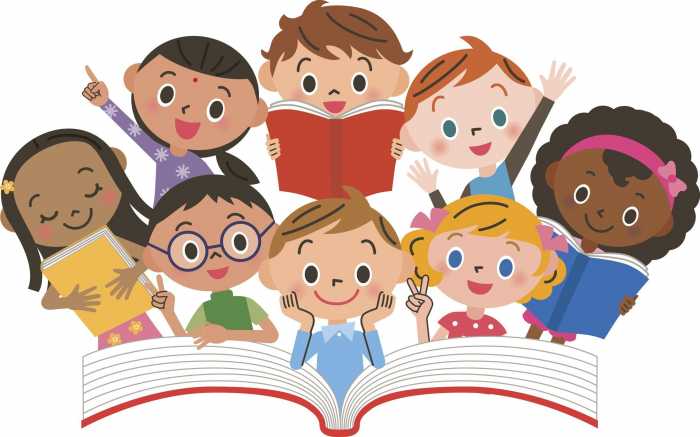
For the older coming-of-age generations (young readers)
We are introduced to Asian-American Lara Jean Song Covey in To All The Boys I’ve Loved Before by Jenny Han, who has an intriguing and heart-felt past. She has a secret – she owns a secret box that holds 5 letters to the 5 different boys she’s ever crushed on! The catch: she has never sent those letters out. It is safe to say young people have their own coping methods when it comes to relationships or platonic loves. The letters are Lara Jean’s best coping method, until someone secretly mails them out! As the plot moves on, readers learn more about Lara Jean’s lifestyle and culture. Lara Jean explains;
“We all have Song for our middle name, and we look more Song than Covey anyway, more Korean than white. At least Margot and I do; Kitty looks most like Daddy: her hair is light brown like his.” (Han, 9).
From Jenny Han’s To All The Boys I’ve Loved Before
This is reflective of where some young readers stand. There are more interracial couples now than what was seen before, and some youth may now be half-Asian and half-Caucasian, half-Asian and half-Latinx, etc. Speaking from some friends’ experiences due to little research done on the matter, there are times when bicultural youth have felt offended that someone automatically assumes they are just Latinx or just African American, when they are both. Take a look at high school senior Natasha Scott’s experience, as stated by The New York Times 8 Scott was torn between listing herself as Asian or African-American for her college applications. Throughout the story, Lara Jean is fully accepting of her two cultures. Jenny Han’s young adult novel can help make diverse young readers feel seen and represented. While there are many diverse books finally being released into the world, more bicultural main characters are still greatly needed because they can help youngsters happily identify with them and feel proud of where they are from, like Lara Jean, who is made up of both Asian and Caucasian cultures.
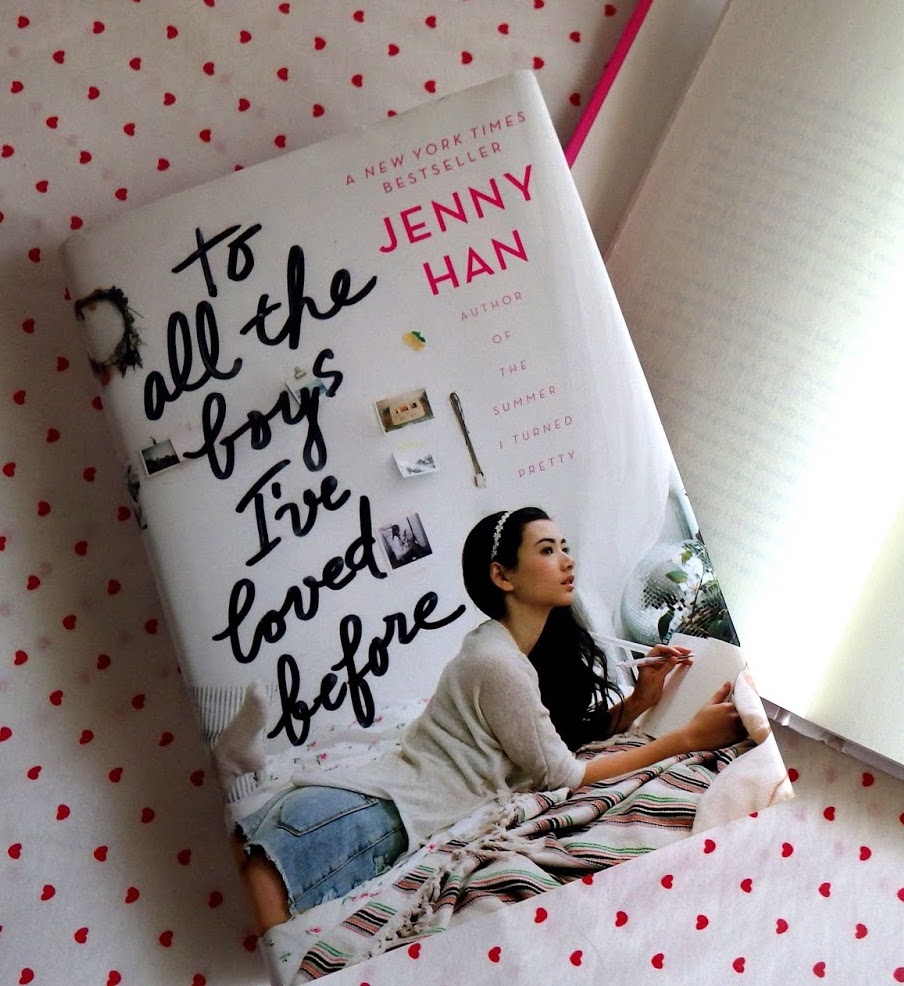
Another great subject Han’s novel brings up is cosplaying a character from another culture. Lara Jean expresses, “there are very limited options for Asian girls on Halloween. Like one year I went as Velma from Scooby-Doo, but people just asked me if I was a manga character. I even wore a wig!” (225). Jenny Han has brought up an issue some young readers may have experienced; being told they cannot dress up as anything else other than someone from their cultural background, or that they may need to change something about their physical appearance to look more like a character. Anyone should be able to cosplay as they wish. Lara Jean shows how it does not matter where you are from, you can love characters from other backgrounds because no barriers exist in the heart.
One of the best parts of the young adult novel is the romance behind Lara Jean and Peter Kavinsky. (SPOILER ALERT!) While they initially begin “dating”, they do not take it seriously. However, as fate would have it, they begin falling for one another and even learn more about their interests and cultural tastes. It is a book that involves acceptance of others who are different from you. During one of their interactions, Lara Jean states, “At the lunch table Peter and his friends can’t get enough of the rice balls. I only get to eat three. ‘These are so good.’ Peter keeps saying.” (Han, 240). Peter goes so far as to hesitate when he’s about to eat the last rice ball, wondering if Lara Jean wants it (very cute moment, I know). This book will appeal to all romance fans.

Readers are given an awesome gift after reading the book – they get to look forward to its film adaptation! It is now on Netflix, or wherever you prefer to stream content. The film producers do an amazing job of keeping its casting true to the story. Viewers see Lara Jean’s family portrayed as they should be. It is important for young readers/viewers to grow up reading and seeing bicultural families as a normal, casual possibility in the world.
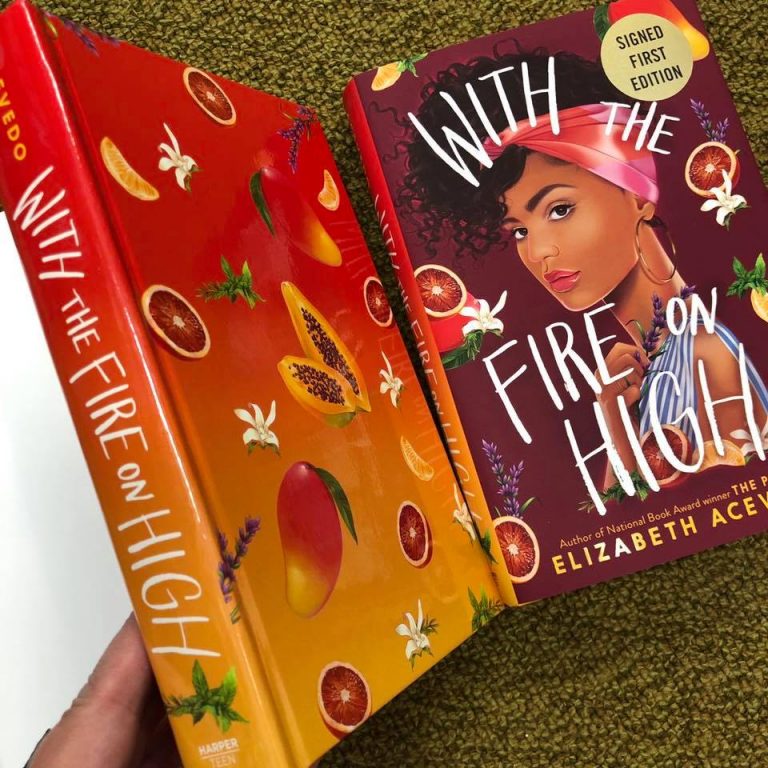
Adding to the diversity in children’s book publishing is With The Fire On High by Elizabeth Acevedo. The plot takes place in Philadelphia, Pennsylvania. Right off the bat young readers get to know that the Afro-Latina protagonist, Emoni Santiago, is a teenage single-mother. It is a topic not widely published, especially with a multicultural character. Emoni has a down-to-earth explanation of why she is a young mother, which some readers may identify with. In addition, Emoni comes from a humble background with an excitement for cooking (I mean, just look at that gorgeous hardcover!). This young adult novel has received many accolades, and rightly so.
As readers follow Emoni on her journey, she delivers powerful dialogue that anyone could relate to, and one does not have to be young to do so. Emoni states about her daughter;
“I wanted to give Babygirl a nice name, [Emma]. The kind of name that doesn’t tell you too much before you meet her, the way mine does. Because nobody ever met a white girl named Emoni, and as soon as they see my name on a résumé or college application they think they know exactly what kind of girl they getting.” (Acevedo, 9).
With The Fire On High by Elizabeth Acevedo
Names tend to have historical context, waning and increasing over time with changes in popular culture. It may not be surprising if you asked someone you know how their name has made them feel at some point in their lives, and they respond with positive and not-so-pleasant memories. Another thing that helps this book stand out over others is the mouth-watering description of Emoni’s cooking. For readers who grew up with a family figure (e.g., mother, abuela) cooking delicious meals like “pollo guisado” with their special sazón, this will take them back to those warm, welcoming cultural memories. To add to the cultural context; it is certain the majority of Latinx readers grew up with a good ol’ “Que Dios te bendiga” from a loved one.
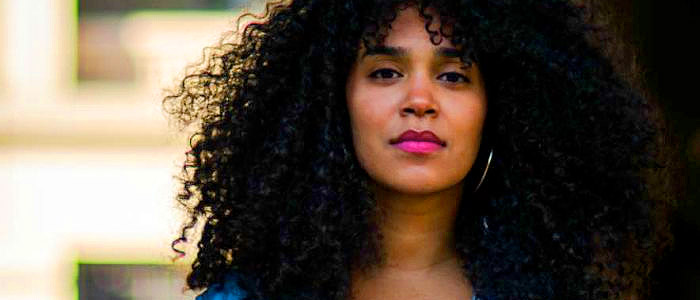
Further into the story, readers are introduced to Malachi, who is Emoni’s love interest. However, their introduction is off to a rocky start when Malachi assumes her race. Emoni clearly states one cannot assume a person’s race simply by how they look. Again, this message is enforced in To All The Boys I’ve Loved Before by Jenny Han. As evidenced in The New York Times 11, young readers may grow up with people mistaking some of them for a certain race. In the article, it is mentioned how there is an “other-race effect”, which is a cognitive occurrence that can make it harder for someone of one race, to recognize someone from another. In Malachi’s case, he assumed Emoni was only African American when she considers herself both African American and Latina. This reading can benefit society by explicitly showing young readers an example of how someone can react if she/he assumes their race. It is now more important than ever to teach young readers to have an open mind.
Similar to carelessly assuming another’s race, it is common knowledge that young readers might fail to see other’s perceptions. Emoni is so absorbed in her own busy lifestyle that she fails to see the perseverance her own grandmother has had throughout the last two years since Emoni had Emma. When Emoni’s ‘Buela (grandmother) begins to disappear from time to time to the point where Emoni eventually confronts her about this, her ‘Buela tells her she wishes to be just “Gloria” (her grandmother’s first name), rather than ‘Buela only, because she also has a right to live life. This is a gripping scene that could enlighten young readers to appreciate the loved ones who take care of them each day. Emoni and her grandmother’s story may also reflect young readers’ parents/guardians – those who single-handedly raise youth to get them going each day. Thus, With The Fire On High allows young readers to see that the single-parent/guardian family lifestyle is shared among others.
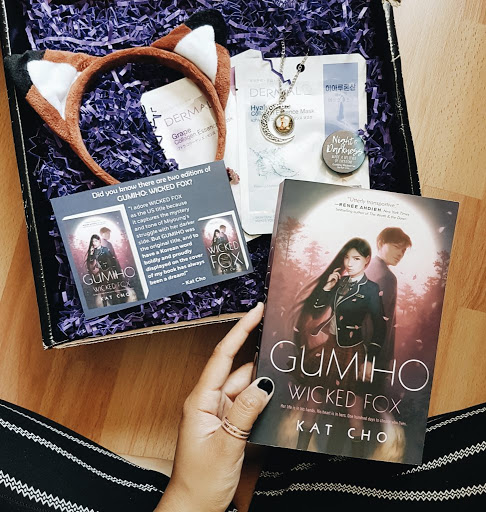
Wicked Fox by Kat Cho is a compelling, young adult fantasy novel filled with suspense and Korean mythology lurking each corner. High schoolers Gu Miyoung and Ahn Jihoon are dangerously gravitating towards the forbidden by society, while trying to keep each other safe. Miyoung is no ordinary girl, she is a gumiho (nine-tailed fox in Korean story-telling) who must devour the livers of men to continue breathing. Jihoon is a young teenage boy who would rather not listen to Miyoung’s warnings to stay away from her. He chooses to stick by her side because “no one belongs alone”.
Set in modern-day Seoul, the story also gives us a cold, harsh mother-daughter relationship. Miyoung has always longed for notable signs of love and affection from her mother because all Miyoung has ever seen is an invisible wall with her. Her mother constantly orders her to behave as a proper gumiho and never let kindness get the better of her. Miyoung, who does not wish to kill innocent people, rebels against her. Many young readers who do not have a strong, positive relationship with their parents/guardians could relate to Miyoung’s story. Additionally, Miyoung has never met her father.

The story offers more Korean folklore as the reader continues. Jihoon explains how his grandmother used to tell him stories of the legendary gumiho. For young readers who have heard of this culture’s mythology, reading words like “gumiho” can be a nice ring to those times, and perhaps a deeper appreciation for it. As the story move along, it is soon known that Jihoon’s parents both abandoned him. Both Miyoung and Jihoon do not have their parents present. This addition to the plot is unique because it supports the fact that not everyone has their parents present either physically and emotionally in life, and young readers who are in that situation can feel included as they read this young adult novel.
Kat Cho’s Wicked Fox is told from both Miyoung and Jihoon’s perspectives, setting a beautiful female and male tone for young readers to identify with, root for, and delve into their minds. It is crucial to beware that everyone thinks differently because that is simple human nature. It is also wonderful that a main character like Jihoon, who is caring, selfless, and helpful is in children’s literature because boys should see that they too have a right to be emotional and feel.

Diverse books such as these cannot be a success and reach readers’ hands without everyone’s help. It is essential for one to go to their favorite library and/or bookstore to check them out, and pass the knowledge of them along by word-of-mouth and/or social media. Something that may not be widely known if you do not work in the book publishing industry is that pre-ordering a book helps diverse authors by a long-shot. Pre-ordering books is a huge assistance because it allows publishers to see there is popular “buzz” and big excitement for a book, thus causing more marketing/publicity efforts for that book. Tell your friend, sibling, student, teacher, doctor, colleague, lover, etc. to check them out and you will help create a positive domino effect in diverse book visibility.
There is no doubt that these multicultural stories have a lot to offer to the world. Their great potential to open the doors for more books like them is bright, and it is with your help that it can be done for a more empathetic, beaming, and inclusive tomorrow. ¡Sí se puede!
Works Cited
- Rich, Motoko. “For Latino Young Readers, An Image Is Missing.” The New York Times. 4 Dec. 2008. Print. ↩
- Wang, Shanshan. “Kids Serve As Translators For Parents Who Speak Little English.” Medill Reports Chicago. 10 May 2006. Print. ↩
- Cullinan, Brenice. “Reading with Your Child”. Launching Young Readers!: Reading Rockets. Print. ↩
- Photo Credit to Brazos Bookstore. ↩
- The Novel Way To Learn Languages. “Why Reading Books is One of the Best Ways to Learn a Foreign Language”. Interlinear Books Blog. ↩
- Photo Credit to Yours Truly. ↩
- Tapia and Rodriguez, “Latino Authenticity and Identity: Assimilate, Opt-Out or Double-Down.” Diversity Best Practices. 18 Sep. 2008. Online ↩
- Saulny and Steinberg. “On College Forms, a Question of Race, or Races, Can Perplex”. The New York Times. 13 June 2011. Print. ↩
- Photo Credit to Marissa Cortes. ↩
- Photo Credit to NW Book Lovers. ↩
- Swarns, Rachel L., “The Science Behind ‘They All Look Alike To Me'”, The New York Times, 20 Sep. 2005. Print. ↩
- Photo Credit to Kath. ↩
What do you think? Leave a comment.











With Stef Soto, I like that the main characters are Mexican-American and children of immigrants, and that the story isn’t about that. It’s about concerns that middle grade kids have: embarrassment about parental vigilance and the family vehicle, anger about rules and restrictions, and confusion about how to handle rumors.
Stef is a super relatable character, especially for me.
I absolutely love your highlight on that! It’s great to have a story about a Mexican-American youngster that involves her everyday life and issues that she wishes to get through.
With the Fire on High was not my typical genre, I ended up getting sucked into it. I loved the setup which reminded me of watching episodes of Degrassi.
A masterpiece. Inspiring, heartfelt, and oh so HAPPY.
This has so many elements of what makes me love Young Adult, with some extra ingredients to make it even better – just a dash of food related magical realism.
Such a good ode to both literal and emotional nourishment.
Wonderful collection! My little girl is just 2 but I will certainly make note of this for the future. I love children’s books. 🤓😘
For younger children (2 and under) I found Yoga Babies brilliant as it simply shows lots of babies from different races. And a recent discovery is Luna Loves Library Day, Luna is a mixed race girl with a white mum and a black dad. These two stories do not discuss race as such but at this age it might be a bit much, but provide a visual stimulation to the fact that people look different.
That’s wonderfully said! – the more visual stimulation to the fact that people are from different cultures at a young age, the bigger the acceptance is possible.
A note for authors. The characters should be the color the author envisions them. Authors should NOT force diversity for the sake of diversity.
Children should be able to see themselves and others in the books they read. It helps tackle problems like racism if children see black, indian, chinese, native american and other races in the books they read. Why should a POC only see white people in books? Authors SHOULD put diversity into their books. If you have to FORCE it, then you are racist. The world is diverse, not just white. The author should envision more than just white.
I agree with Eloy. It is race, sexuality, gender, privilege/oppression, mental and physical disabilities, and minorities. These are the groups that are underrepresented in not only children’s literature but other works of literature as well. Being white is not a crime and neither is being black or any other race. The crime is allowing our children and/or students to lack cultural competence in a world that is culturally driven. Kids are intrigued by relatability and often cannot find that in literature. It is our jobs (members of any society) to ensure that children’s voices are being heard through literature. I agree that it shouldn’t be a force, but an author’s job is to create well-rounded characters with characteristics that are associated with being good or bad. This falls into the stereotypes that are presented in the world. Giving children and students access to diversity allows them form opinions on the content and generalize about the dangers of these stereotypes and labels and how to fight against them.
Loved ‘Love, Sugar, Magic’! It was great to finally see a Hispanic family that looked like my own – with a protagonist that is Texan, Mexican-American and fully Hispanic without also being fluent in Spanish and/or a recent immigrant. That plus the fun magical realism
Great representation, wonderful family dynamics, and such warmth.
Characters like Laura Jean are not only funny but incredibly relatable. I’m a heavy fantasy reader, but after a while, you need a break. That book was perfect for that.
Me too sister. I am generally not the biggest fan of romance and contemporary YA and yet I found myself needing something relatively light to read. This was the perfect choice!
Humor is one of the best things to have in a book, I’m glad Jenny Han’s novel included that.
I really like the book “Ghost” by Jason Reynolds. It has great representation. Look it up!
Thank you so much for this list! I’m pregnant and am so happy to have found it. 🙂
Beautifully written Yvonne. Thank you so much for sharing! I’m currently creating a training for early childhood educators on how to incorporate really good multicultural and diverse literature into their classrooms. This was a great help!
Thank you, Joeann!! 🙂 It’s beautiful to hear that! I really enjoyed putting together part of my take on multicultural stories. If this can help students find parts of themselves, the better 📚
I love it when I find new books to try with my daughter. We’ve read one already before I discovered your article. It’s funny we’ve just checked out “To All The Boys I’ve Loved Before” last week. 🙂
Awesome, happy reading!!
Ah… Leo made questionable decisions, but shes 11, learning her way in a new world of magic.
My daughter and I would read this book every night before bed. We were hooked. I love that the author is a WOC and from Texas. I love how she incorporates our culture and the Spanish language.
My daughter and I really enjoyed it, and I LOVED that it represented our culture. It reminded me so much of how I grew up and how I interact with my sisters.
What I liked most about Strange Birds was how the group coalesced slowly, without any of the usual “oh wow they magically totally get along” tropes.
Really wanted to like this one more than I did. Terrific activism message but a disjointed story.
I have to agree. I think, at points, the girls’ voices were difficult to distinguish, and I felt that the author tried to give nods to a whole bunch of different social issues in a way that felt very clumsy. The adults in the story seemed like cardboard cutouts as well.
Hmm. I am on the fence about this one. There are some excellent elements: a diverse group of middle school girls, diverse in ethnicity, family situation, economics, attitude, personality and interests, that are drawn together because not only do they not match each other, they are all strange birds with no pre-made flock to join. There is an environmental element, a push back at over-protective family theme and a draw in distant family theme among several others. But while the girls had distinct personalities and the plot was straightforward enough the whole thing never quite jelled for me. I could see the characters moved around by the hand of an adult (stand on the edge of this cliff waving your arms around). I could feel a sentimental need to tie up loose ends (a dog that attacks the girls is suddenly domesticatible ). What I really appreciated was how messy the girls conversations were: they would talk about fraught race and class issues, crack a joke, get angry and then have some snacks.
I loved everything about this book. Its the kind of book that my 12-year-old self would have devoured and been strongly influenced by. I
I adored Celia C. Pérez’s The First Rule of Punk!
Ah, that’s another great story! Glad you mentioned it 🙂
I related a lot to Lara Jean. We’re both half white and half Asian (she’s Korean, I’m Filipino). We also both look more Asian than white. We both don’t like driving. At one point she says that it’s practically a weapon and I agree. We both wear berets. In general I’m in love with how Lara Jean dresses. We both like old/antique stuff.
I loved how the book managed to lightly touch upon being Asian and being slut shamed.
Clothing isn’t usually highlighted in characters, it’s great you mentioned it. Sometimes, audiences can connect through that (I know I have)! It’d be cool to know the author’s inspiration for the character’s clothing style.
Wicked Fox is the first Korean based book Ive ever read and I loved the shit out of this book. There were a few twists I personally didnt see coming.
The characters were amazing, with the side characters (Jihoon’s Grandma was an absolute blessing) striking and such an asset to the book. I honestly adored everything about this book.
Same here! I love it and am so looking forward to its sequel, Vicious Spirits!
Great list- thanks!!
You’re very welcome!
This is such an issue and there are so many people who do not know about it! Thank you for the great article. Diversity is most important. I’m buying “Elevator Magic” for my nephew who happens to be a white autistic child. He will love it. <3
Happy to have written it :D! I hope your nephew loves it too! May I also recommend “Wonder” by R.J. Palacio? It’s a beautiful classic that helps represent both physical diversity and culture.
Wonderful piece! These are books I want to read myself hahaha- and I just learned there is a little one on the way in the family and I’ll be a first time aunt! And seeing these books makes me so excited for the little one to grow and get to reading these.
I think you’re welcome to read them all, no matter who they’re written for :)!
the age group they’re written for**
In Strange Birds, I loved that each of their stories felt very realistic and were different in significant ways. And I loved that they initially don’t really bond, but do eventually become friends.
YES! Points for activism, diversity, actual range of interests on the parts of the characters. I think this would make a cute movie.
This is a great resource. Thank you so much!
You’re welcome :)!
Great article………………. you explain very well in this article about Children’s Books
Thank you! Glad you enjoyed it 🙂
Diverse kids books are so important so that kids can relate to the characters and learn that not all people are the same.
100% yes !
This is excellent and reflects the desire of my heart! My love of books, community and writing compels me to support and advocate for quality literature representing all children across the globe.
Thank you so much, Jacobson! My joy with books and community compelled me to write this.
I read A Dash of Trouble aloud to my six and eight year olds at home. We loved Leo, her curiosity, and her sweet and loving family. My daughter, a girl with quite the sweet tooth, loved the bakery!
I wanted to eat everything mentioned in this book, and was happy to see recipes in the back!
I am so glad to see this published!This was super informative article for me because I have never read any of these books. It is great to expose young kids with different cultures and these books are a fun and engaging way to do so. It is also great to know that immigrant kids can relate to characters in popular teens and children’s stories.
Anyone no matter their status can relate to the mentioned stories! They’re written for everyone 👏🏽 which makes them great.
There is so much unchallenged white power images and messages in modern America, from tv media to childrens books and toys. This propaganda often has the effect of poisoning young minds into believing in a kind of white supremacy, if you will.
Eh, these books all look fine, but I’m not sure I agree with the author’s claim that “multicultural” stories are some kind of ground-breaking novelty, even in children’s entertainment. Technically, for instance, anyone who reads manga or watches anime is having a “multicultural” experience by virtue of the fact that those media come from Japan. I also remember reading stories that featured multiracial main characters when I was in elementary and middle school (such as, for instance, a book about a biracial British kid who could speak to lions), and that was decades ago.
Also, this might be a coincidence, but it seems like most of the stories mentioned in this article revolve around food, for some reason.
Wow, it is a total coincidence that many of the mentioned books involved food. Haha! Didn’t even notice! It’s not about “groundbreaking”, it’s about representing EVERYONE. It’s been reported that not everyone read about diverse characters in books. You may research it 🙂
I am so so happy that children’s books and movies are finally reflecting the diversity of our society. However, I think it’s important to always keep in mind WHO is doing the representing. In the past, it has been really problematic when an actor/actress played a character that belonged to a different racial group. So while it’s important to write in a culturally diverse cast, the actors/actresses must reflect that reality. Also, authors that write characters that differ from their own cultural identity must consider the power-dynamic of this practice. For example, it would be unsettling to learn that a Caucasian author was writing and representing a hispanic youth in her children’s novel. Overall, although having diverse characters is something we should aim for, there are more nuances that must be considered.
You’re right, mainstream media (e.g., television, film) needs to have actors that represent everyone! Not just culturally, physically and mentally too (e.g, people with disabilities, people that do not fit under the “ideal beauty” standard. 👏🏽
It’s always great to find books that have characters my students can relate to.
To all the boys I’ve loved before instantly reminded me of Brooke’s letters to Lucas on One Tree Hill.
I just want to keep these books in my pocket so I can hand it out to kids everywhere.
That’s sweet! Nice.
This was such a wonderful read! I’m a little bit older than the target YA demographic, but I think that there’s still something that I can learn from each of these books. The different representations of childhood from multiethnic children are something that I feel like I didn’t get an opportunity to see that much so I’m so glad that the next generation will have the opportunity to see themselves reflected in art.
Go for it! – Read these books and enjoy the knowledge.
I’m delving more into YA now, and I’m older than the demographic, too. I don’t think it matters, though. I’ve found several highly enjoyable examples.
We need diverse voices now more than ever. I’m happy that publishers see the potential in making sure everyone is represented in the literary community.
Thank you for the support! 👏🏼
Beautiful article. Having grown up in a rural white area hurting for diversity, I wish these books had been around when I was growing up. I think I’m gonna check out some of the YA ones. Fire on High keeps popping up lately, and it looks amazing.
Ah Stephanie 😊 Thank you lots! I really recommend you read them all! If you do, feel free to leave a comment with your thoughts.
Thanks. I’m also thinking about writing a similar article, focused on disability-positive novels.
Awesome, let us know if you do!
Good essay. The book, Strange Birds, I’ll need to look it up. Sometimes that is what you want from an essay, to be introduced to unfamiliar books.
Nice, spreading the word about diverse books is among the goals. I’m glad I was able to introduce you to new ones 🙂
Update for the author: I read With the Fire on High and really enjoyed it. Now I want a sequel where we get to see Emoni go to college and work at the restaurant, and we get to see Babygirl grow up.
That would be cool to read! Glad you liked it :)! Elizabeth Acevedo recently published a new book, “Clap When You Land” if you wish to read more from her.
I was reading a Malcolm Gladwell’s book Blink and he talks about reworking our schema of people with different identities than our own and one of the many points he made was that it’s important to be exposed to the best things of a culture. I’m really excited to see books that represent so many facets of cultures help the next generation process difference as something unique and positive.
Woo woo, that excitement is everywhere and is here to stay!
It is pleasing to see how good work is being done at the grassroots level to promote inclusivity. Having somebody to identify with helps make life a smoother journey. The article reminded me of the long stimulating conversations I have had with my peers in psychiatry. Seven billion and counting, yet, each person is uniquely different from the other in so many aspects that it is really easy to feel alone and lost.
It really does (helps make life a smoother journey)! I will add it also helps builds a more understanding and empathetic relationship/conversation.
I love how diversity is increasingly being highlighted in books, especially being a person of colour (POC).
I do agree that sometimes diversity can be forced (i.e. including a POC character only for the sake of “diversity” but not fleshing them out and/or portraying them as token characters). But genuine representation in books is definitely up-and-coming, and I’m here for it!
Here here!
As a voracious reader who was constantly hunting down books with strong female protagonists, I appreciate the value of seeing yourself and your experiences in the characters you read about and look up to. I love seeing these diverse books directed at all ages become more accessible to everyone! As someone who grew up attending PWIs with traditional, white-centered curriculums, I can hardly think of more than two or three children’s/YA books I read featuring POC as the main characters. I’m so glad to see that changing because I know my non-white classmates must have rarely seen themselves reflected and I know that I missed out on so many learning opportunities. Now it’s time to go order some of these books from my local library and catch up with the kids!
THANK YOU! Love to hear you’re a voracious reader like myself 😀
Note: Some of these characters are not based on my own experiences, they were from an objective point-of-view and what I’ve seen in society.
YES! Support your local libraries and bookstores!
I love this article because it captures how important it is for children to have exposure to diversity. I am about to be a new mom, and this article was so important for me honestly. I think this is something that we often do not focus on. We talk about diversity amongst adults, but seem to forget our kids in the conversation. I think that you captured the essence of what good the exposure can do for younger people as well.
Thank you, Rhea! Congrats on your new journey!
Exactly, youth need to feel seen and there is still an ongoing process for this to happen continuously.
I love how I’m seeing more representation in children’s reading material now, especially as it teaches them of the importance of accepting those of other ethnicities as equal to them. This is crucial at this point in time, specifically, with the rise of racism and racial awareness. Great article touching on important concepts.
Thank you, Mishani! I really appreciate the time you took to read it, and hope to hear if you read any of them now 🙂
Definitely an example of elements of other cultures being incorporated into the American.